credit/source: youtube.com and K/DA and League of Legends
AdSense
Friday, November 6, 2020
POP/STARS - Opening Ceremony Presented by Mastercard | Finals | 2018 Wor...
credit.source: youtube.com, Pop Stars and League of legends
Monday, August 10, 2020
Plague Overview,Symptoms,Causes, Transmission and Treatment
Overview
Plague is an infectious disease caused by Yersinia pestis bacteria, usually found in small mammals and their fleas. The disease is transmitted between animals via their fleas and, as it is a zoonotic bacterium, it can also transmit from animals to humans.
Humans can be contaminated by the bite of infected fleas, through direct contact with infected materials, or by inhalation. Plague can be a very severe disease in people, particularly in its septicaemic and pneumonic forms, with a case-fatality ratio of 30% - 100% if left untreated.
Although plague has been responsible for widespread pandemics throughout history, including the so-called Black Death that caused over 50 million deaths in Europe during the fourteenth century, today it can be easily treated with antibiotics and the use of standard preventative measures.
Plague is found on all continents except Oceania but most human cases since the 1990s have occurred in Africa. Democratic Republic of Congo, Madagascar and Peru are the three most endemic countries.
Symptoms
People infected with plague usually develop influenza-like symptoms after an incubation period of 3–7 days. Symptoms include fever, chills, aches, weakness, vomiting and nausea.
There are 3 main forms of plague.
Bubonic plague is the most common and is caused by the bite of an infected flea. The plague bacillus, Y. pestis, enters at the bite and travels to the nearest lymph node to replicate. The lymph node becomes inflamed, tense and painful, and is called a bubo. With advanced infections, the inflamed lymph nodes can turn into suppurating open sores. Bubonic plague cannot be transmitted from human to human.
Septicaemic plague occurs when infection spreads through the bloodstream. It may result from flea bites or from direct contact with infective materials through cracks in the skin. Advanced stages of the bubonic form of plague will also lead to direct spread of Y. pestis in the blood.
Pneumonic plague – or lung-based plague – is the most virulent and least common form of plague. Typically, it is caused by spread to the lungs from advanced bubonic plague. However, a person with secondary pneumonic plague may form aerosolized infective droplets and transmit plague to other humans. This is usually fatal.
Treatment
Untreated plague can be rapidly fatal, so early diagnosis and treatment is essential for survival and to reduce complications. Antibiotics and supportive therapy are effective against plague if patients are diagnosed in time.
Laboratory testing is required to confirm infection. This includes identifying the causative bacteria in a sample of pus from a bubo, blood or sputum. WHO does not recommend vaccination except for high-risk people such as laboratory personnel and health care workers.
Preventive measures include informing people when zoonotic plague is present in their environment and giving advice on how they can protect themselves. They should be advised to take precautions against flea bites and not to handle animal carcasses. People, especially health workers, should also avoid direct contact with infected tissues such as buboes, or close exposure to patients with pneumonic plague.
credit/source: https://www.who.int/health-topics/plague#tab=tab_1
Plague
Cause
The plague bacillus, Yersinia pestis.
Transmission
Plague is a zoonotic disease affecting rodents and transmitted by fleas from rodents to other animals and to humans. Direct person-to-person transmission does not occur except in the case of pneumonic plague, when respiratory droplets may transfer the infection from the patient to others in close contact.
Nature of the disease
Plague occurs in three main clinical forms:
- Bubonic plague is the form that usually results from the bite of infected fleas. Lymphadenitis develops in the drainage lymph nodes, with the regional lymph nodes most commonly affected. Swelling, pain and suppuration of the lymph nodes produces the characteristic plague buboes.
- Septicaemic plague may develop from bubonic plague or occur in the absence of lymphadenitis. Dissemination of the infection in the bloodstream results in meningitis, endotoxic shock and disseminated intravascular coagulation.
- Pneumonic plague may result from secondary infection of the lungs following dissemination of plague bacilli from other body sites. It produces severe pneumonia. Direct infection of others may result from transfer of infection by respiratory droplets, causing primary pulmonary plague in the recipients.
Without prompt and effective treatment, 50–60% of cases of bubonic plague are fatal, while untreated septicaemic and pneumonic plague are invariably fatal.
Geographical distribution
There are natural foci of plague infection in rodents in many parts of the world. Wild rodent plague is present in central, eastern and southern Africa, South America, the western part of North America and in large areas of Asia. In some areas, contact between wild and domestic rats is common, resulting in sporadic cases of human plague and occasional outbreaks.
Risk for travellers
Generally low except in rural areas of countries or areas at risk, particularly if camping or hunting or if there is contact with rodents.
Prophylaxis
A vaccine effective against bubonic plague is available exclusively for individuals with a high occupational exposure to plague; it is not commercially available in most countries.
Precautions
Avoid any contact with live or dead rodents.
Note: All information and image/s are credited to the original writer's source/s and reference/s.
Please click the link/s for complete information.
The information contained on this site is for educational purposes only and
should not be taken as expert advice.
Saturday, March 14, 2020
If you think you have been exposed to COVID-19 and develop a fever and symptoms
Symptoms
phone icon
Call your doctor: If you think you have been exposed to COVID-19 and develop a fever and symptoms, such as cough or difficulty breathing, call your healthcare provider for medical advice.
Watch for symptoms
Reported illnesses have ranged from mild symptoms to severe illness and death for confirmed coronavirus disease 2019 (COVID-19) cases.
The following symptoms may appear 2-14 days after exposure.*
- Fever
- Cough
- Shortness of breath
*This is based on what has been seen previously as the incubation period of MERS-CoV viruses.
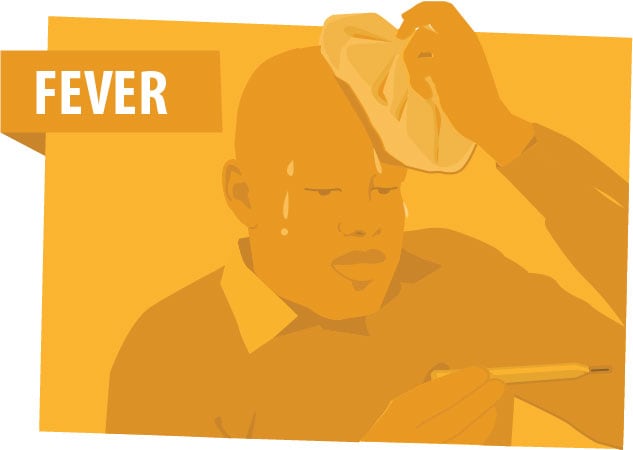
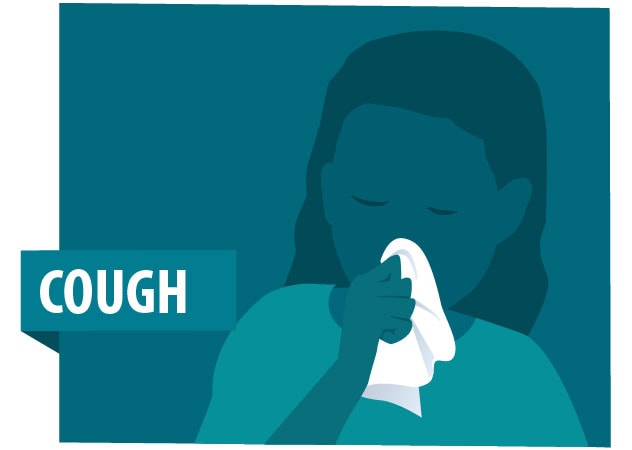
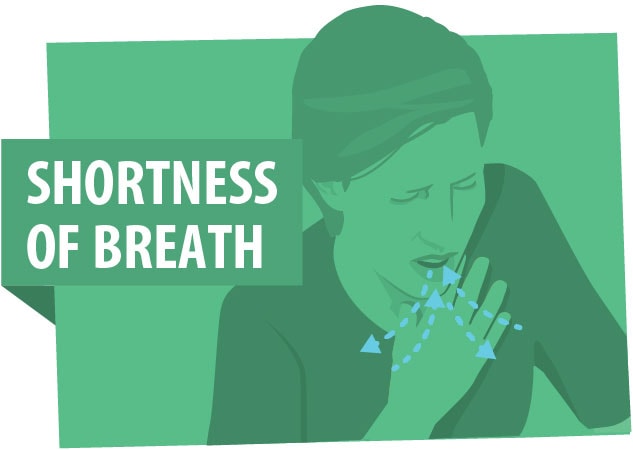
alert icon
If you develop emergency warning signs for COVID-19 get medical attention immediately. Emergency warning signs include*:
- Difficulty breathing or shortness of breath
- Persistent pain or pressure in the chest
- New confusion or inability to arouse
- Bluish lips or face
*This list is not all inclusive. Please consult your medical provider for any other symptoms that are severe or concerning.
Reducing Stigma
Public health emergencies, such as the outbreak of coronavirus disease 2019 (COVID-19), are stressful times for people and communities. Fear and anxiety about a disease can lead to social stigma (1) toward people, places, or things. For example, stigma and discrimination can occur when people associate a disease, such as COVID-19, with a population or nationality, even though not everyone in that population or from that region is specifically at risk for the disease. Stigma can also occur after a person has been released from COVID-19 quarantine even though they are not considered a risk for spreading the virus to others.
It is important to remember that people – including those of Asian descent – who do not live in or have not recently been in an area of ongoing spread of the virus that causes COVID-19, or have not been in contact with a person who is a confirmed or suspected case of COVID-19 are not at greater risk of spreading COVID-19 than other Americans.
Some groups of people who may be experiencing stigma because of COVID-19 include:
- Persons of Asian descent
- People who have traveled
- Emergency responders or healthcare professionals
Stigma hurts everyone by creating fear or anger towards other people.
Stigmatized groups may be subjected to:
- Social avoidance or rejection
- Denials of healthcare, education, housing or employment
- Physical violence.
Stigma affects the emotional or mental health (2) of stigmatized groups and the communities they live in. Stopping stigma is important to making communities and community members resilient (3). See resources on mental health and coping during COVID-19.
Everyone can help stop stigma related to COVID-19 by knowing the facts and sharing them with others in your community.
Communicators and public health officials can help counter stigma during the COVID-19 response.
- Maintain privacy and confidentiality of those seeking healthcare and those who may be part of any contact investigation.
- Quickly communicate the risk or lack of risk from associations with products, people, and places.
- Raise awareness about COVID-19 without increasing fear.
- Share accurate information about how the virus spreads.
- Speak out against negative behaviors, including negative statements on social media about groups of people, or exclusion of people who pose no risk from regular activities.
- Be cautious about the images that are shared. Make sure they do not reinforce stereotypes.
- Engage with stigmatized groups in person and through media channels including news media and social media.
- Thank healthcare workers and responders. People who have traveled to areas where the COVID-19 outbreak is happening to help have performed a valuable service to everyone by helping make sure this disease does not spread further.
- Share the need for social support for people who have returned from China or are worried about friends or relatives in the affected region.
Key Terms
- Stigma occurs when people associate a risk with a specific people, place, or thing – like a minority population group – and there is no evidence that the risk is greater in that group than in the general population. Stigmatization is especially common in disease outbreaks. (https://emergency.cdc.gov/cerc/cerccorner/article_123016.asp)
- Mental health is defined by the World Health Organization as a state of well being in which a person realizes his or her own abilities, can cope with normal stresses of life, can work productively and fruitfully, and is able to make a contribution to his or her community (https://www.who.int/news-room/fact-sheets/detail/mental-health-strengthening-our-responseexternal icon).
- Resilience is the ability to withstand and recover from stress. (https://blogs.cdc.gov/publichealthmatters/2017/08/predicting-community-resilience-and-recovery-after-a-disaster/)
Other Preparedness Resources
Note: All information and image/s are credited to the original writer's source/s and reference/s.
Please click the link/s for complete information.
The information contained on this site is for educational purposes only and
should not be taken as expert advice.
What To Do if You Are Sick?
What To Do if You Are Sick
phone icon
Call your doctor: If you think you have been exposed to COVID-19 and develop a fever and symptoms, such as cough or difficulty breathing, call your healthcare provider for medical advice.
Steps to help prevent the spread of COVID-19 if you are sick
Follow the steps below: If you are sick with COVID-19 or suspect you are infected with the virus that causes COVID-19, follow the steps below to help prevent the disease from spreading to people in your home and community.
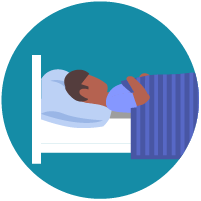
Stay home except to get medical care
- Stay home: People who are mildly ill with COVID-19 are able to isolate at home during their illness. You should restrict activities outside your home, except for getting medical care.
- Avoid public areas: Do not go to work, school, or public areas.
- Avoid public transportation: Avoid using public transportation, ride-sharing, or taxis.
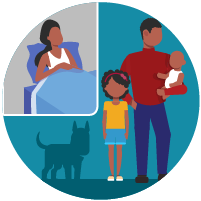
Separate yourself from other people and animals in your home
- Stay away from others: As much as possible, you should stay in a specific room and away from other people in your home. Also, you should use a separate bathroom, if available.
- Limit contact with pets & animals: You should restrict contact with pets and other animals while you are sick with COVID-19, just like you would around other people. Although there have not been reports of pets or other animals becoming sick with COVID-19, it is still recommended that people sick with COVID-19 limit contact with animals until more information is known about the virus.
- When possible, have another member of your household care for your animals while you are sick. If you are sick with COVID-19, avoid contact with your pet, including petting, snuggling, being kissed or licked, and sharing food. If you must care for your pet or be around animals while you are sick, wash your hands before and after you interact with pets and wear a facemask. See COVID-19 and Animals for more information.
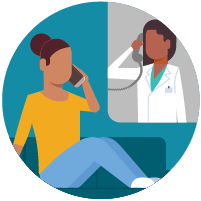
Call ahead before visiting your doctor
- Call ahead: If you have a medical appointment, call the healthcare provider and tell them that you have or may have COVID-19. This will help the healthcare provider’s office take steps to keep other people from getting infected or exposed.
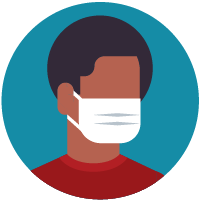
Wear a facemask if you are sick
- If you are sick: You should wear a facemask when you are around other people (e.g., sharing a room or vehicle) or pets and before you enter a healthcare provider’s office.
- If you are caring for others: If the person who is sick is not able to wear a facemask (for example, because it causes trouble breathing), then people who live with the person who is sick should not stay in the same room with them, or they should wear a facemask if they enter a room with the person who is sick.
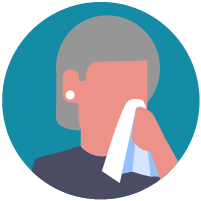
Cover your coughs and sneezes
- Cover: Cover your mouth and nose with a tissue when you cough or sneeze.
- Dispose: Throw used tissues in a lined trash can.
- Wash hands: Immediately wash your hands with soap and water for at least 20 seconds or, if soap and water are not available, clean your hands with an alcohol-based hand sanitizer that contains at least 60% alcohol.
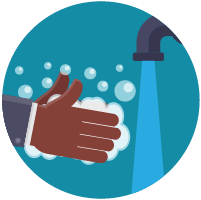
Clean your hands often
- Wash hands: Wash your hands often with soap and water for at least 20 seconds, especially after blowing your nose, coughing, or sneezing; going to the bathroom; and before eating or preparing food.
- Hand sanitizer: If soap and water are not readily available, use an alcohol-based hand sanitizer with at least 60% alcohol, covering all surfaces of your hands and rubbing them together until they feel dry.
- Soap and water: Soap and water are the best option if hands are visibly dirty.
- Avoid touching: Avoid touching your eyes, nose, and mouth with unwashed hands.
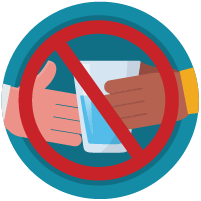
Avoid sharing personal household items
- Do not share: You should not share dishes, drinking glasses, cups, eating utensils, towels, or bedding with other people or pets in your home.
- Wash thoroughly after use: After using these items, they should be washed thoroughly with soap and water.
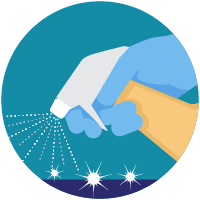
Clean all “high-touch” surfaces everyday
- Clean and disinfect: Practice routine cleaning of high touch surfaces.
High touch surfaces include counters, tabletops, doorknobs, bathroom fixtures, toilets, phones, keyboards, tablets, and bedside tables.
- Disinfect areas with bodily fluids: Also, clean any surfaces that may have blood, stool, or body fluids on them.
- Household cleaners: Use a household cleaning spray or wipe, according to the label instructions. Labels contain instructions for safe and effective use of the cleaning product including precautions you should take when applying the product, such as wearing gloves and making sure you have good ventilation during use of the product.
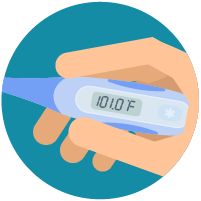
Monitor your symptoms
- Seek medical attention: Seek prompt medical attention if your illness is worsening (e.g., difficulty breathing).
- Call your doctor: Before seeking care, call your healthcare provider and tell them that you have, or are being evaluated for, COVID-19.
- Wear a facemask when sick: Put on a facemask before you enter the facility. These steps will help the healthcare provider’s office to keep other people in the office or waiting room from getting infected or exposed.
- Alert health department: Ask your healthcare provider to call the local or state health department. Persons who are placed under active monitoring or facilitated self-monitoring should follow instructions provided by their local health department or occupational health professionals, as appropriate.
alert icon
Call 911 if you have a medical emergency: If you have a medical emergency and need to call 911, notify the dispatch personnel that you have, or are being evaluated for COVID-19. If possible, put on a facemask before emergency medical services arrive.
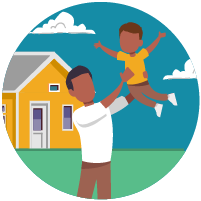
Discontinuing home isolation
- Stay at home until instructed to leave: Patients with confirmed COVID-19 should remain under home isolation precautions until the risk of secondary transmission to others is thought to be low.
- Talk to your healthcare provider: The decision to discontinue home isolation precautions should be made on a case-by-case basis, in consultation with healthcare providers and state and local health departments.
Footnote
- a) being within approximately 6 feet (2 meters) of a COVID-19 case for a prolonged period of time; close contact can occur while caring for, living with, visiting, or sharing a health care waiting area or room with a COVID-19 case
– or –
- b) having direct contact with infectious secretions of a COVID-19 case (e.g., being coughed on)
If such contact occurs while not wearing recommended personal protective equipment or PPE (e.g., gowns, gloves, NIOSH-certified disposable N95 respirator, eye protection), criteria for PUI consideration are met.
See CDC’s updated Interim Healthcare Infection Prevention and Control Recommendations for Persons Under Investigation for 2019 Novel Coronavirus.
Data to inform the definition of close contact are limited. Considerations when assessing close contact include the duration of exposure (e.g., longer exposure time likely increases exposure risk) and the clinical symptoms of the person with COVID-19 (e.g., coughing likely increases exposure risk as does exposure to a severely ill patient). Special consideration should be given to those exposed in health care settings.
Note: All information and image/s are credited to the original writer's source/s and reference/s.
Please click the link/s for complete information.
The information contained on this site is for educational purposes only and
should not be taken as expert advice.
How COVID-19 Spreads?
How It Spreads
COVID-19 is a new disease and we are still learning how it spreads, the severity of illness it causes, and to what extent it may spread in the United States.
How COVID-19 Spreads
Person-to-person spread
The virus is thought to spread mainly from person-to-person.
- Between people who are in close contact with one another (within about 6 feet).
- Through respiratory droplets produced when an infected person coughs or sneezes.
These droplets can land in the mouths or noses of people who are nearby or possibly be inhaled into the lungs.
Can someone spread the virus without being sick?
- People are thought to be most contagious when they are most symptomatic (the sickest).
- Some spread might be possible before people show symptoms; there have been reports of this occurring with this new coronavirus, but this is not thought to be the main way the virus spreads.
Spread from contact with contaminated surfaces or objects
It may be possible that a person can get COVID-19 by touching a surface or object that has the virus on it and then touching their own mouth, nose, or possibly their eyes, but this is not thought to be the main way the virus spreads.
How easily the virus spreads
How easily a virus spreads from person-to-person can vary. Some viruses are highly contagious (spread easily), like measles, while other viruses do not spread as easily. Another factor is whether the spread is sustained, spreading continually without stopping.
The virus that causes COVID-19 seems to be spreading easily and sustainably in the community (“community spread”) in some affected geographic areas.
Community spread means people have been infected with the virus in an area, including some who are not sure how or where they became infected.
Situation in U.S.
Different parts of the country are seeing different levels of COVID-19 activity. The United States nationally is currently in the initiation phases, but states where community spread is occurring are in the acceleration phase. The duration and severity of each phase can vary depending on the characteristics of the virus and the public health response.
- CDC and state and local public health laboratories are testing for the virus that causes COVID-19. View CDC’s Public Health Laboratory Testing map.
- More and more states are reporting cases of COVID-19 to CDC.
- U.S. COVID-19 cases include:
- Imported cases in travelers
- Cases among close contacts of a known case
- Community-acquired cases where the source of the infection is unknown.
- Three U.S. states are experiencing sustained community spread.
- View latest case counts, deaths, and a map of states with reported cases.
International Areas with Sustained (Ongoing) Transmission
Last updated March 12, 2020
- China (Level 3 Travel Health Notice)
- Iran (Level 3 Travel Health Notice)
- Most of Europe (Level 3 Travel Health Notice)
- South Korea (Level 3 Travel Health Notice)
- Global Outbreak Notice (Level 2 Travel Health Notice)
For additional information, please visit CDC’s Travel Information page.
Related Links
Note: All information and image/s are credited to the original writer's source/s and reference/s.
Please click the link/s for complete information.
The information contained on this site is for educational purposes only and
should not be taken as expert advice.
Subscribe to:
Posts (Atom)